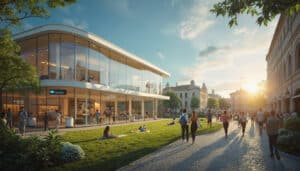« `html
Imagine turning a beach invasion into a green revolution. Experts from across the Caribbean have gathered in Guadeloupe to tackle the sargassum surge. With scientific strides and innovative minds, the future looks algae-green.
This lively colloquium marks the launch of the second phase of the SARGCOOP project, aiming to transform the pesky sargassum invasions into valuable resources. Building on the initial phase’s success in mapping algal wash-ups, the focus now shifts to optimizing detection methods and exploring sustainable applications. Researchers are buzzing with ideas, particularly about converting these abundant seaweeds into biocarbon fuels, potentially revolutionizing the renewable energy landscape.
Ulises Jauregui-Haza from the Institut Technologique de Saint-Domingue emphasizes the dual benefit of processing sargassum alongside agricultural waste. « Developing processes to treat both sargassum and agricultural residues could pave the way for innovative waste valorization strategies, » he notes. The collaborative spirit is palpable, with countries like Mexico, Cuba, and Costa Rica contributing data and investments to the initiative.
Lydia Barfleur, director of regional cooperation in Guadeloupe, highlights the broader impact: « When our biodiversity suffers, so do our fisheries and tourism. Sustainable solutions are crucial for the long-term prosperity of the Caribbean. » The alliance not only addresses a common environmental and health concern but also aspires to set a benchmark in renewable energy development.
As the team moves forward, the optimism is infectious. The transformation of sargassum from a nuisance to a resource underscores the ingenuity and resilience of the Caribbean scientific community. With continued support and innovation, the SARGCOOP project is poised to make waves in both environmental management and energy production.
« `html
Table of contents
ToggleThe sargassum invasion: a Caribbean dilemma?
Every year, the Caribbean grapples with the sudden influx of sargassum – those pesky brown algae that seem to have a personal vendetta against pristine beaches. Imagine waking up to seas turning into green mudslides, not exactly the postcard-perfect scene tourists rave about. But amid the frustration and the sandcastle-destroying waves, a silver lining is emerging. Caribbean nations are flipping the script, transforming this environmental headache into a treasure trove of valuable resources. How? Through a blend of innovation, scientific collaboration, and a dash of regional ingenuity.
What are sargassum and why do they matter?
Sargassum is no ordinary seaweed. Floating in large mats across the Atlantic, these algae have become a double-edged sword for the Caribbean. On one hand, their massive blooms clog beaches, disrupt marine ecosystems, and hurt the tourism industry. On the other, they are a biomass goldmine waiting to be tapped. Understanding sargassum’s role is crucial, as it affects everything from local fisheries to the environmental health of island nations. Researchers have long studied its growth patterns, trying to predict blooms and mitigate damage. But the latest advancements are not just about control—they’re about conversion and creation.
How scientists are tracking sargassum with SARGCOOP
The battle against sargassum isn’t fought on beaches alone; it’s a high-tech pursuit. Enter the SARGCOOP project, a collaborative initiative spearheaded by Caribbean experts and supported by international allies. From 2019 to 2023, Phase I focused on identifying algae deposition patterns based on ocean currents. Now, in Phase II, the emphasis shifts to enhancing detection mechanisms and, more importantly, the valorization of sargassum. This means not only predicting where the algae will wash up but also developing sustainable ways to repurpose it. The ultimate goal? Turning a problematic nuisance into a cornerstone of renewable energy.
Transforming sargassum into biofuel: the renewable breakthrough
Imagine turning seaweed into eco-friendly fuel. Sounds like something out of a sci-fi movie, doesn’t it? Yet, that’s precisely what Caribbean researchers are striving to achieve. By processing sargassum, they aim to create biocarbon, a sustainable alternative to fossil fuels. This transformation involves breaking down the algae into its basic components and then converting them into usable energy forms. The potential is immense—not only could this reduce reliance on imported fuels, but it also addresses the environmental impact of sargassum on coastal communities. Researchers like Ulises Jauregui-Haza from the Institut Technologique de Saint-Domingue are leading the charge, developing methods to efficiently convert algae into biofuel while minimizing waste.
Regional collaborations: Caribbean nations unite for sustainable solutions
Addressing the sargassum issue isn’t a task for one island alone. The Caribbean’s diversity is its strength, and regional cooperation has become the key to effective solutions. Countries like Mexico, Cuba, Costa Rica, the Dominican Republic, Saint Lucia, Trinidad and Tobago, and various Overseas Collectivities have come together to share data, resources, and expertise. Lydia Barfleur, Director of Regional Cooperation in Guadeloupe, emphasizes the importance of this alliance: « When our biodiversity is affected, and our fisheries and tourism suffer, the sustainable development of all Caribbean territories is at stake. » This collective approach ensures that innovations in one nation can benefit all, creating a network of sustainable practices that bolster the entire region.
Case study: Barbados unveils algae-derived vehicle fuel
One of the most exciting developments comes from Barbados, where researchers have taken a giant leap forward by introducing the first vehicle powered by fuel derived from sargassum. This groundbreaking achievement not only showcases the practical applications of sargassum valorization but also sets a precedent for other Caribbean nations to follow. The project involved rigorous testing to ensure the biofuel met the necessary standards for efficiency and safety. Early results are promising, indicating that algae-based fuel can compete with conventional options without compromising performance. This milestone not only reduces the environmental footprint of transportation but also provides a scalable model for future renewable energy projects in the region.
Future prospects: from marine nuisance to energy pioneer
The journey from battling sargassum on the shores to harnessing it as a valuable resource is a testament to Caribbean innovation. As research progresses, the potential applications of sargassum are expanding beyond biofuels. Bioplastics, agricultural fertilizers, and even construction materials are on the horizon, each offering sustainable alternatives to traditional products. The success of initiatives like SARGCOOP underscores the importance of investing in scientific research and regional partnerships. With continued support and collaboration, the Caribbean can turn what was once a dreaded influx of seaweed into a cornerstone of renewable energy and sustainable development, paving the way for a greener, more resilient future.














